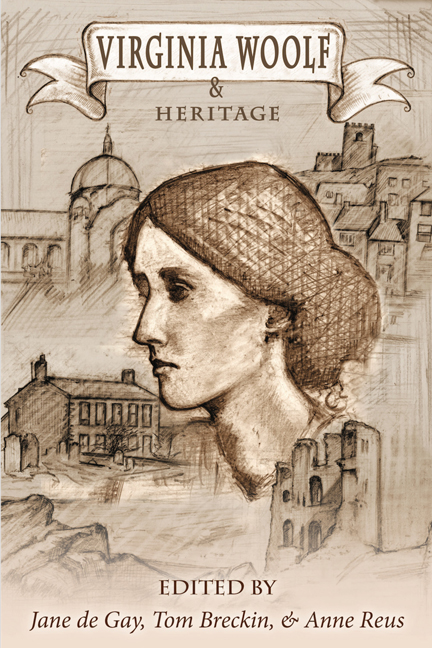Book contents
- Frontmatter
- Contents
- Introduction
- List of Abbreviations
- HERITAGE: A DEBATE
- HERITAGE, EDUCATION, AND MENTORING
- HERITAGE SPACES
- LITERARY AND CULTURAL HERITAGES
- QUEER PASTS
- MODERNISM AND HERITAGE
- WRITING LIVES AND HISTORIES
- The Play of Fact and Fiction in Virginia Stephen's “The Journal of Mistress Joan Martyn”
- “Writing the history of my own times”: Virginia Woolf and the Diary
- Heritage, Legacy, and the Life-Writing of Woolf and Rhys
- Life as Legacy: Truth, Fiction, and Fidelity of Representation in Biographical Novels Featuring Virginia Woolf
- From the Author to the Icon: A Heritage of Virginia Woolf in French Biographies and Biofictions
- Flights of Archival Imagination: Woolf 's Transcendent Materiality in Contemporary “Archive Fiction”
- WOOLF'S LEGACIES
- FINALE
- Notes on Contributors
From the Author to the Icon: A Heritage of Virginia Woolf in French Biographies and Biofictions
from WRITING LIVES AND HISTORIES
- Frontmatter
- Contents
- Introduction
- List of Abbreviations
- HERITAGE: A DEBATE
- HERITAGE, EDUCATION, AND MENTORING
- HERITAGE SPACES
- LITERARY AND CULTURAL HERITAGES
- QUEER PASTS
- MODERNISM AND HERITAGE
- WRITING LIVES AND HISTORIES
- The Play of Fact and Fiction in Virginia Stephen's “The Journal of Mistress Joan Martyn”
- “Writing the history of my own times”: Virginia Woolf and the Diary
- Heritage, Legacy, and the Life-Writing of Woolf and Rhys
- Life as Legacy: Truth, Fiction, and Fidelity of Representation in Biographical Novels Featuring Virginia Woolf
- From the Author to the Icon: A Heritage of Virginia Woolf in French Biographies and Biofictions
- Flights of Archival Imagination: Woolf 's Transcendent Materiality in Contemporary “Archive Fiction”
- WOOLF'S LEGACIES
- FINALE
- Notes on Contributors
Summary
A biography “is not a work of art, but something betwixt and between” writes Virginia Woolf, a hybrid text mixing fact and fiction (D3 125). Daniel Madélénat attributes this conception of biography to the “modern biography,” post-Freudian, non positivist, more artistic (65). However, this hybridization of fact and fiction cannot be reduced to the specific context of modernism since it defines the genre of biography itself, which is an “impure genre” (Dosse 57) or, to put it in Kendall's words, the place of a “conflict between the demands of simulation and the implicability of fact” (Kendall 16). In any biography, fact pertains to historical truth, documentary proof, and chronology; fiction entails the selection of the events, their organization, and the “biographical relationship” (Boyer-Weimann) deciding of the viewpoint adopted. Contemporary French authors, in particular, have experimented with various biographical narrations, from Patrick Modiano with Dora Bruder (1997) to Jean-Benoît Puech with Une Biographie autorisee (2010), in which a fictitious biographer, Yves Savigny, writes the life of Benjamin Jordane, a fictitious writer, under whose name Puech signed some of his books! Biography as a genre thus questions the status of an author. Through these variable proportions of fact and fiction, biography leads to ask not only how should one tell a life, but what should a reader do with an author's life (see Meizoz).
Knowing that biographies and biofictions of Virginia Woolf have flowered over the last thirty years in France, what have these biographers of Virginia Woolf done with her biographical heritage, at the crossroad of her image and the biographical forms she proposed in Orlando and Flush, and Roger Fry? How do they deal with her iconicity—the fascination she inspires—within the tension between invention and fictionality at the heart of biography?
Since typologies are reshapeable, and the names themselves unstable,1 they will be left aside: rather, the texts of our corpus will be analyzed as different formulas, increasingly creative, and will allow me to highlight the process of iconization I wish to describe. We will begin with Viviane Forrester, whose biography, Virginia Woolf (2009), reinforces the pedestal Woolf was put on in early feminist writings.
- Type
- Chapter
- Information
- Virginia Woolf and Heritage , pp. 217 - 222Publisher: Liverpool University PressPrint publication year: 2017



